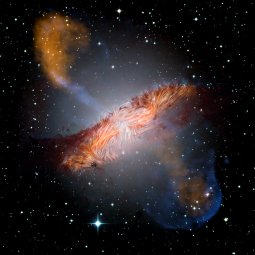By Enrique Lopez Rodrigues & Joan Schmelz
Paper:
The Magnetic Field Across the Molecular Warped Disk of Centaurus A
Lopez-Rodriguez, E., Nat Astron (2021).
Magnetic fields are thought to be generated at early stages of the universe from inhomogeneties and anisotropies of electric charges. Thus, the fields that we observe today are the result of the amplification of that ‘seed’ field due to galaxy formation, accretion flows to supermassive black holes, and supernovae explosions. The understanding of the origin, amplification, and morphology of the magnetic fields is crucial for a complete picture of galaxy evolution.
Thanks to radio polarimetric observations, nearby galaxies are known to have large-scale spiral-like coherent magnetic field structures of kpc-scales. These magnetic fields are thought to be generated by galactic dynamos that convert kinetic to magnetic energy. This conversion can be performed via small-scale turbulent fields and differential rotation of the galactic disk to amplify and order the magnetic fields. Current theories can be divided into large-scale dynamos, which produce ordered magnetic fields on scales larger than the flow scale, and small-scale dynamos, generated at scales smaller than the energy-carrying eddies.
Recently, more attention has been given to small-scale dynamos as they require more generic flows and exhibit faster magnetic field growth. The amplification of small-scale fields is of the order of the smallest turbulent eddy turnover time scale. This is important because the small-scale fields allow amplification even in clusters and ellipticals. It can also explain strong magnetic fields in high-redshift galaxies when the universe was much younger and large-scale dynamo amplification times were not sufficient. Magnetohydrodynamic simulations suggest that weak initial `seed' fields were first amplified by a small-scale dynamo during a violent, feedback-dominated early phase in the galaxy formation history, which was followed by a more quiescent evolution where the magnetic fields have slowly decayed or were maintained via large-scale dynamo action.
Centaurus A is the remnant of a merger between an elliptical and a spiral galaxy that took place about 160 million years ago. The most prominent feature is the giant jets extending up to 250 kpc into the intergalactic medium. These jets are generated by accretion onto the supermassive black hole at the core of the galaxy. The active nucleus is located within a chaotic dust lane, a warped remnant of the spiral galaxy that cuts the halo of the elliptical in half. At a close astronomical distance of only 3.4 Mpc, Centaurus A represents one of the best laboratories to study the effects of galaxy mergers on magnetic fields. Thus, Centaurus A can be used as an analog of mergers in the early universe.
SOFIA recently observed the warped molecular disk of Centaurus A with the High-resolution Airborne Wideband Camera-plus (HAWC+) at 89 microns with an angular resolution of 7.8” (~125 pc). These observations show that the magnetic field orientation is tightly aligned with the disk. Since the dust lane is a remnant of the spiral galaxy, a large-scale regular field should be present, but when a three-dimensional large-scale regular field was fit to the observations, results show that the dispersion of the observed magnetic field orientations are larger than the uncertainties associated to each measurement. Thus, another mechanism must be producing the angular dispersion in the magnetic field orientations across the warped disk.
Since dynamos convert kinetic to magnetic energy, the measurements of the velocity dispersion of molecular gas can be used as a proxy for the quantification of the turbulence gas. Results show that the thermal polarization observed with HAWC+ decreases with increasing velocity dispersion, which is higher in the warped disk that in other areas of the galaxy. This result implies that turbulence gas at scales smaller than the angular resolution of the observations are distorting the original large-scale regular magnetic field from the spiral galaxy. The interpretation is that the small-scale turbulent fields are relatively more important across the warped disk than large-scale regular fields. These results imply that SOFIA has observed the small-scale fields in action, which may explain the enhancement of the magnetic fields over cosmic time.
